2019 VOLKSWAGEN T-ROC child seat
[x] Cancel search: child seatPage 74 of 502
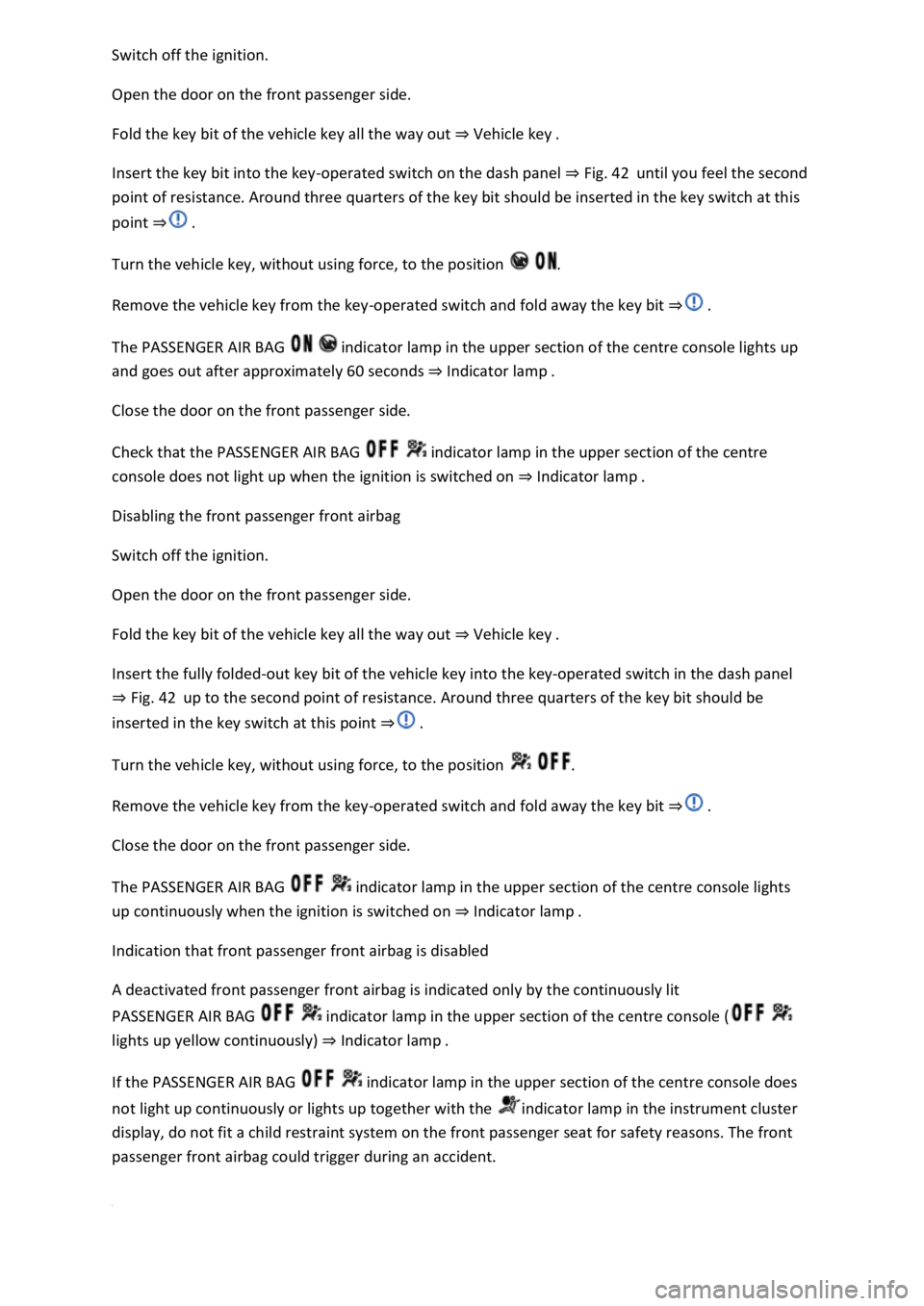
Open the door on the front passenger side.
Fold the key bit of the vehicle key all the way out Vehicle key
Insert the key bit into the key-operated switch on the dash panel Fig. 42until you feel the second
point of resistance. Around three quarters of the key bit should be inserted in the key switch at this
point
Turn the vehicle key, without using force, to the position .
Remove the vehicle key from the key-operated switch and fold away the key bit
The PASSENGER AIR BAG indicator lamp in the upper section of the centre console lights up
and goes out after approximately 60 seconds Indicator lamp
Close the door on the front passenger side.
Check that the PASSENGER AIR BAG indicator lamp in the upper section of the centre
console does not light up when the ignition is switched on Indicator lamp
Disabling the front passenger front airbag
Switch off the ignition.
Open the door on the front passenger side.
Fold the key bit of the vehicle key all the way out Vehicle key
Insert the fully folded-out key bit of the vehicle key into the key-operated switch in the dash panel
Fig. 42up to the second point of resistance. Around three quarters of the key bit should be
inserted in the key switch at this point
Turn the vehicle key, without using force, to the position .
Remove the vehicle key from the key-operated switch and fold away the key bit
Close the door on the front passenger side.
The PASSENGER AIR BAG indicator lamp in the upper section of the centre console lights
up continuously when the ignition is switched on Indicator lamp
Indication that front passenger front airbag is disabled
A deactivated front passenger front airbag is indicated only by the continuously lit
PASSENGER AIR BAG indicator lamp in the upper section of the centre console (
lights up yellow continuously) Indicator lamp
If the PASSENGER AIR BAG indicator lamp in the upper section of the centre console does
not light up continuously or lights up together with the indicator lamp in the instrument cluster
display, do not fit a child restraint system on the front passenger seat for safety reasons. The front
passenger front airbag could trigger during an accident.
Page 75 of 502
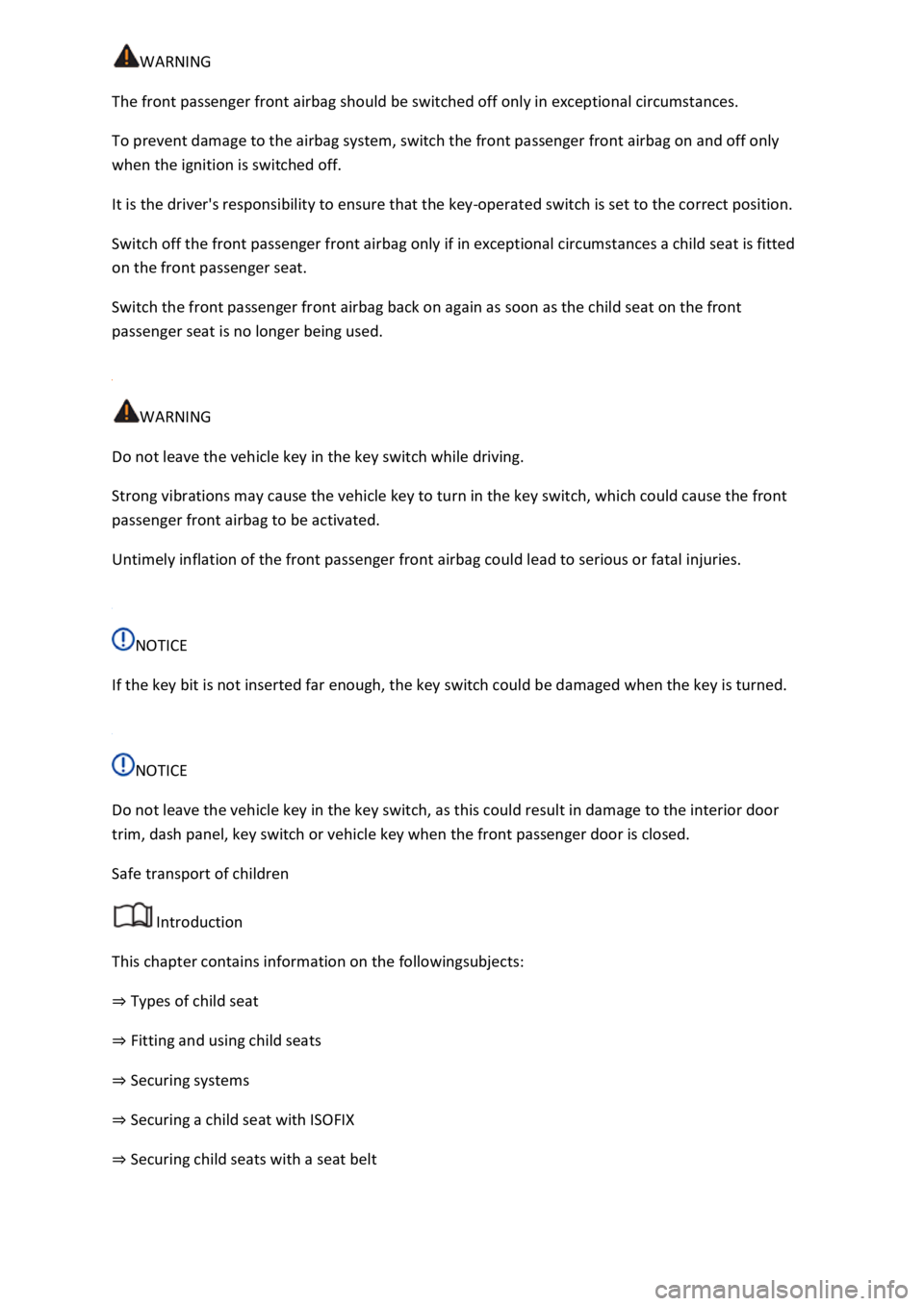
The front passenger front airbag should be switched off only in exceptional circumstances.
To prevent damage to the airbag system, switch the front passenger front airbag on and off only
when the ignition is switched off.
It is the driver's responsibility to ensure that the key-operated switch is set to the correct position.
Switch off the front passenger front airbag only if in exceptional circumstances a child seat is fitted
on the front passenger seat.
Switch the front passenger front airbag back on again as soon as the child seat on the front
passenger seat is no longer being used.
WARNING
Do not leave the vehicle key in the key switch while driving.
Strong vibrations may cause the vehicle key to turn in the key switch, which could cause the front
passenger front airbag to be activated.
Untimely inflation of the front passenger front airbag could lead to serious or fatal injuries.
NOTICE
If the key bit is not inserted far enough, the key switch could be damaged when the key is turned.
NOTICE
Do not leave the vehicle key in the key switch, as this could result in damage to the interior door
trim, dash panel, key switch or vehicle key when the front passenger door is closed.
Safe transport of children
Introduction
This chapter contains information on the followingsubjects:
Types of child seat
Fitting and using child seats
Securing systems
Securing a child seat with ISOFIX
Securing child seats with a seat belt
Page 76 of 502

seats when driving with children.
Note the following:
Child seats are classified into groups depending on the size, age and weight of child for which they
are designed.
Various securing systems are used to secure child seats in the vehicle.
For safety reasons, child seats must always be fitted to the rear seats Fitting and usi
Volkswagen recommends child seats from the Volkswagen range of accessories. These child seats
have been developed and approved for use in Volkswagen vehicles.
WARNING
If children are not secured or are inadequately secured, they are at greater risk of serious or even
fatal injury. Please note the following:
Children who are either under twelve years of age or less than 150 cm tall must not be carried in the
vehicle if they are not secured in a suitable child seat while the vehicle is in motion. Regulations in
some countries may differ and must be complied with.
Always secure children in the vehicle in a suitable child seat. The seat used must be appropriate to
the child's height, weight and age.
Never fasten more than one child into one child seat.
Under no circumstances should children or babies be held in a passenger's or drivers lap while
driving.
Never leave a child unsupervised in a child seat.
Never allow a child to be carried in a vehicle without being properly secured, and never allow a child
to stand up or to kneel on a seat, or to sit incorrectly while the car is in motion. This is particularly
important for children carried on the front passenger seat. In an accident, children may sustain
serious injuries to themselves and others.
The child seat can provide maximum protection only if the seat belt is routed correctly around it.
Always ensure that the seat belt is routed as specified in the instructions provided by the child seat
manufacturer. If the seat belt is routed incorrectly, injuries may occur even in a minor accident.
After an accident, it is vital to replace any child seats that were in use during the accident, as they
could have sustained non-visible damage.
Types of child seat
Page 77 of 502
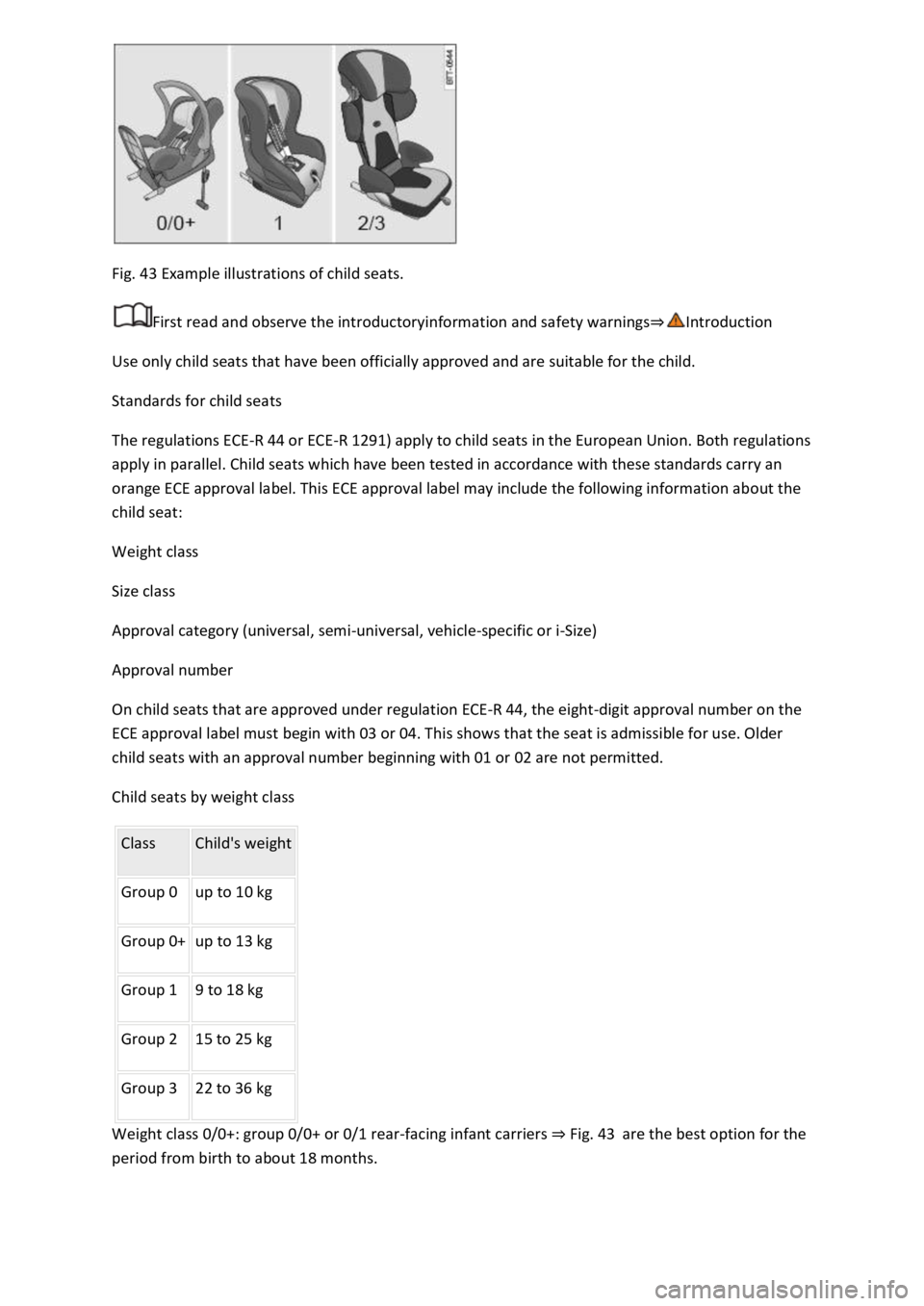
Fig. 43 Example illustrations of child seats.
First read and observe the introductoryinformation and safety warnings
Use only child seats that have been officially approved and are suitable for the child.
Standards for child seats
The regulations ECE-R 44 or ECE-R 1291) apply to child seats in the European Union. Both regulations
apply in parallel. Child seats which have been tested in accordance with these standards carry an
orange ECE approval label. This ECE approval label may include the following information about the
child seat:
Weight class
Size class
Approval category (universal, semi-universal, vehicle-specific or i-Size)
Approval number
On child seats that are approved under regulation ECE-R 44, the eight-digit approval number on the
ECE approval label must begin with 03 or 04. This shows that the seat is admissible for use. Older
child seats with an approval number beginning with 01 or 02 are not permitted.
Child seats by weight class
Class Child's weight
Group 0 up to 10 kg
Group 0+ up to 13 kg
Group 1 9 to 18 kg
Group 2 15 to 25 kg
Group 3 22 to 36 kg
Weight class 0/0+: group 0/0+ or 0/1 rear-facing infant carriers Fig. 43are the best option for the
period from birth to about 18 months.
Page 78 of 502
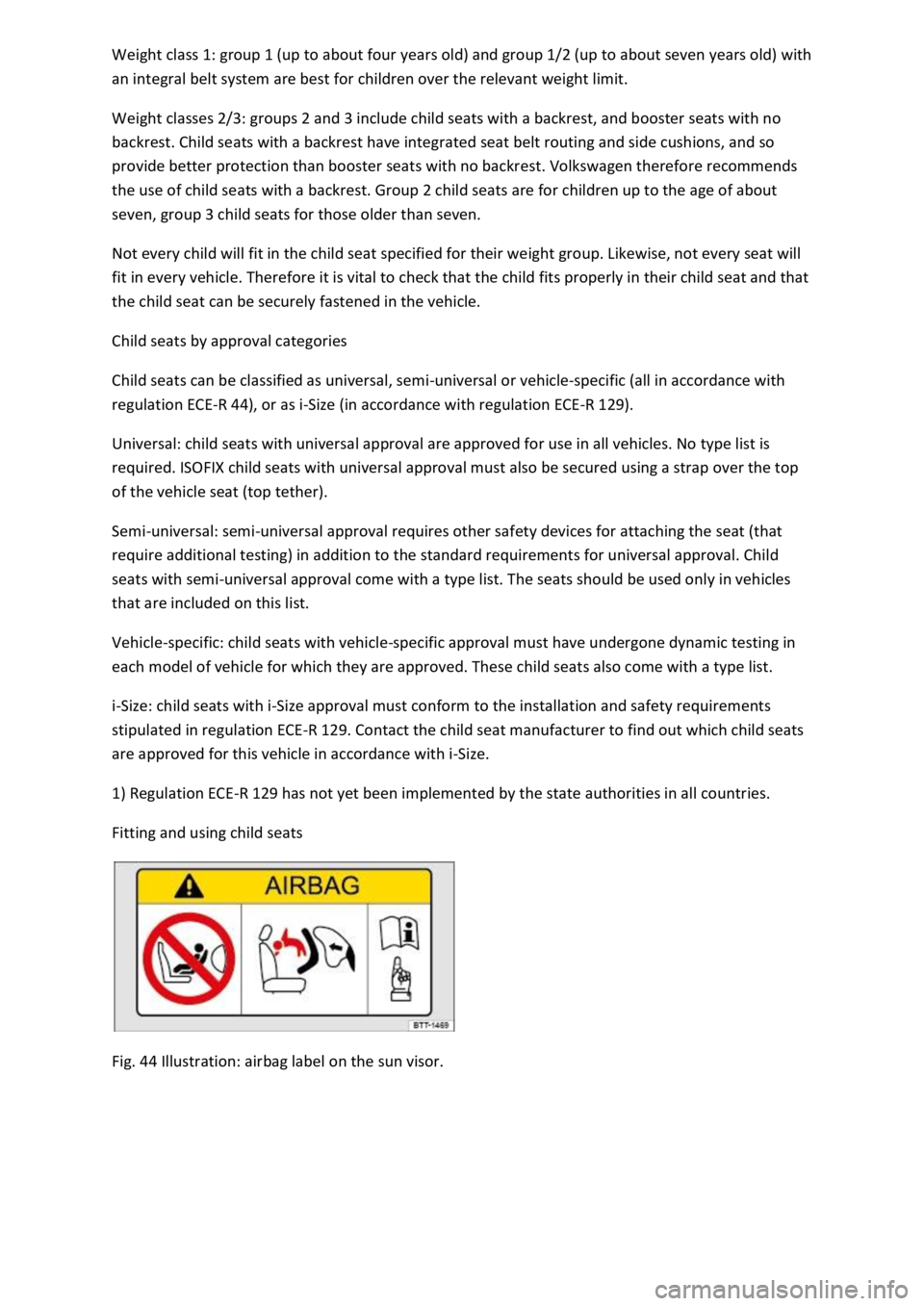
years old) and group 1/2 (up to about seven years old) with
an integral belt system are best for children over the relevant weight limit.
Weight classes 2/3: groups 2 and 3 include child seats with a backrest, and booster seats with no
backrest. Child seats with a backrest have integrated seat belt routing and side cushions, and so
provide better protection than booster seats with no backrest. Volkswagen therefore recommends
the use of child seats with a backrest. Group 2 child seats are for children up to the age of about
seven, group 3 child seats for those older than seven.
Not every child will fit in the child seat specified for their weight group. Likewise, not every seat will
fit in every vehicle. Therefore it is vital to check that the child fits properly in their child seat and that
the child seat can be securely fastened in the vehicle.
Child seats by approval categories
Child seats can be classified as universal, semi-universal or vehicle-specific (all in accordance with
regulation ECE-R 44), or as i-Size (in accordance with regulation ECE-R 129).
Universal: child seats with universal approval are approved for use in all vehicles. No type list is
required. ISOFIX child seats with universal approval must also be secured using a strap over the top
of the vehicle seat (top tether).
Semi-universal: semi-universal approval requires other safety devices for attaching the seat (that
require additional testing) in addition to the standard requirements for universal approval. Child
seats with semi-universal approval come with a type list. The seats should be used only in vehicles
that are included on this list.
Vehicle-specific: child seats with vehicle-specific approval must have undergone dynamic testing in
each model of vehicle for which they are approved. These child seats also come with a type list.
i-Size: child seats with i-Size approval must conform to the installation and safety requirements
stipulated in regulation ECE-R 129. Contact the child seat manufacturer to find out which child seats
are approved for this vehicle in accordance with i-Size.
1) Regulation ECE-R 129 has not yet been implemented by the state authorities in all countries.
Fitting and using child seats
Fig. 44 Illustration: airbag label on the sun visor.
Page 79 of 502
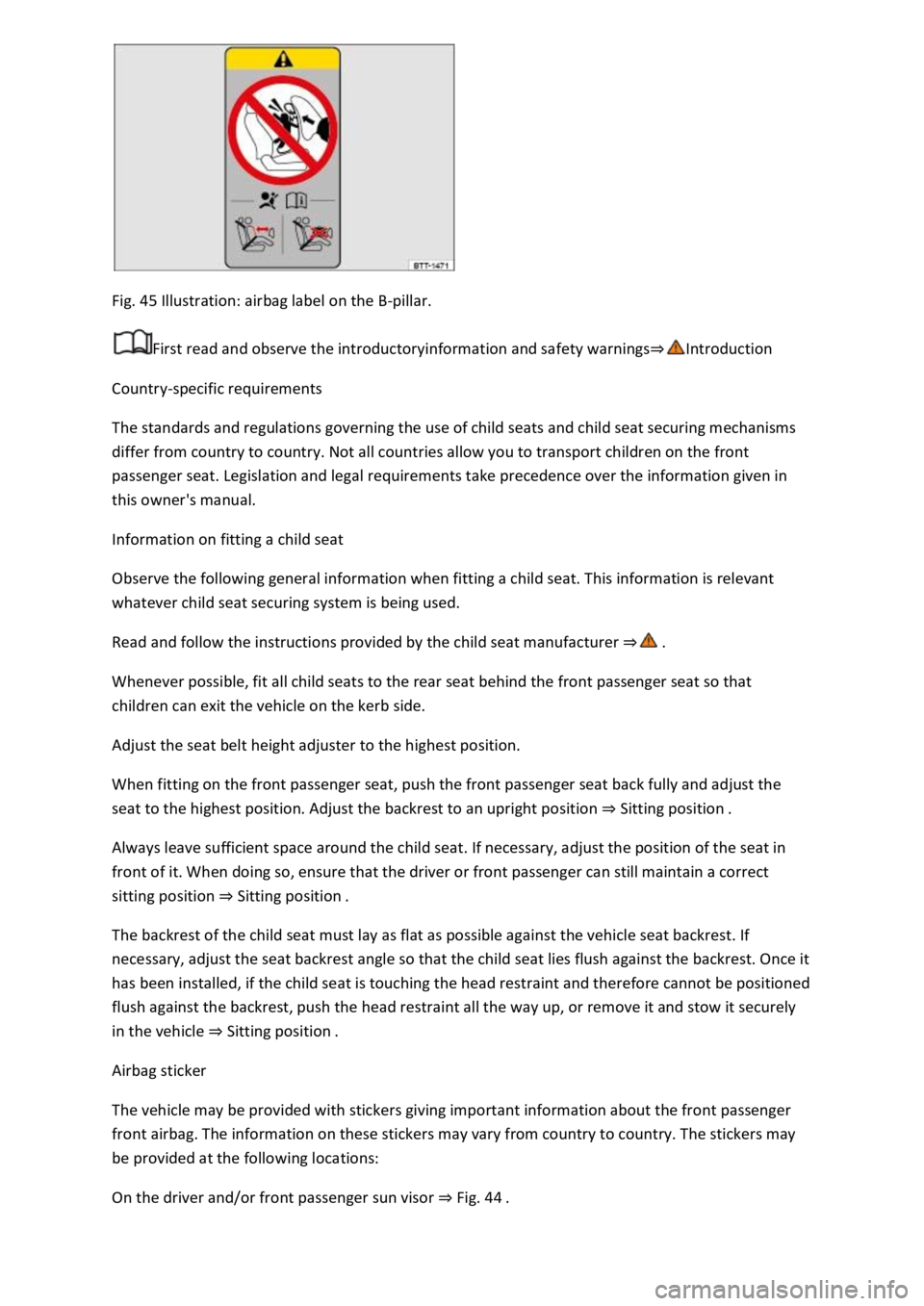
Fig. 45 Illustration: airbag label on the B-pillar.
First read and observe the introductoryinformation and safety warnings
Country-specific requirements
The standards and regulations governing the use of child seats and child seat securing mechanisms
differ from country to country. Not all countries allow you to transport children on the front
passenger seat. Legislation and legal requirements take precedence over the information given in
this owner's manual.
Information on fitting a child seat
Observe the following general information when fitting a child seat. This information is relevant
whatever child seat securing system is being used.
Read and follow the instructions provided by the child seat manufacturer
Whenever possible, fit all child seats to the rear seat behind the front passenger seat so that
children can exit the vehicle on the kerb side.
Adjust the seat belt height adjuster to the highest position.
When fitting on the front passenger seat, push the front passenger seat back fully and adjust the
seat to the highest position. Adjust the backrest to an upright position Sitting position
Always leave sufficient space around the child seat. If necessary, adjust the position of the seat in
front of it. When doing so, ensure that the driver or front passenger can still maintain a correct
sitting position Sitting position
The backrest of the child seat must lay as flat as possible against the vehicle seat backrest. If
necessary, adjust the seat backrest angle so that the child seat lies flush against the backrest. Once it
has been installed, if the child seat is touching the head restraint and therefore cannot be positioned
flush against the backrest, push the head restraint all the way up, or remove it and stow it securely
in the vehicle Sitting position
Airbag sticker
The vehicle may be provided with stickers giving important information about the front passenger
front airbag. The information on these stickers may vary from country to country. The stickers may
be provided at the following locations:
On the driver and/or front passenger sun visor Fig. 44
Page 80 of 502
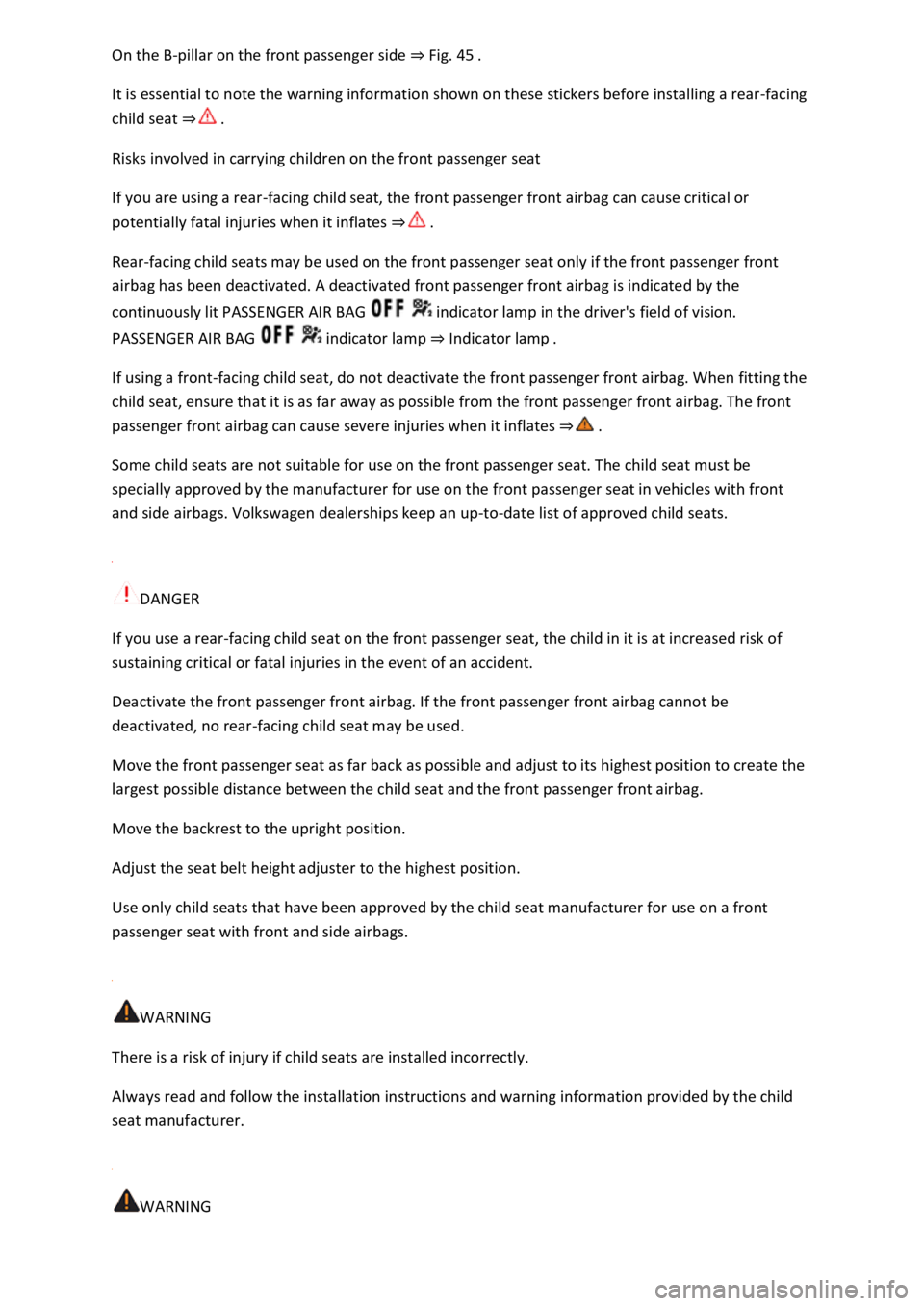
-pillar on the front passenger side Fig. 45
It is essential to note the warning information shown on these stickers before installing a rear-facing
child seat
Risks involved in carrying children on the front passenger seat
If you are using a rear-facing child seat, the front passenger front airbag can cause critical or
potentially fatal injuries when it inflates
Rear-facing child seats may be used on the front passenger seat only if the front passenger front
airbag has been deactivated. A deactivated front passenger front airbag is indicated by the
continuously lit PASSENGER AIR BAG indicator lamp in the driver's field of vision.
PASSENGER AIR BAG indicator lamp Indicator lamp
If using a front-facing child seat, do not deactivate the front passenger front airbag. When fitting the
child seat, ensure that it is as far away as possible from the front passenger front airbag. The front
passenger front airbag can cause severe injuries when it inflates
Some child seats are not suitable for use on the front passenger seat. The child seat must be
specially approved by the manufacturer for use on the front passenger seat in vehicles with front
and side airbags. Volkswagen dealerships keep an up-to-date list of approved child seats.
DANGER
If you use a rear-facing child seat on the front passenger seat, the child in it is at increased risk of
sustaining critical or fatal injuries in the event of an accident.
Deactivate the front passenger front airbag. If the front passenger front airbag cannot be
deactivated, no rear-facing child seat may be used.
Move the front passenger seat as far back as possible and adjust to its highest position to create the
largest possible distance between the child seat and the front passenger front airbag.
Move the backrest to the upright position.
Adjust the seat belt height adjuster to the highest position.
Use only child seats that have been approved by the child seat manufacturer for use on a front
passenger seat with front and side airbags.
WARNING
There is a risk of injury if child seats are installed incorrectly.
Always read and follow the installation instructions and warning information provided by the child
seat manufacturer.
WARNING
Page 81 of 502
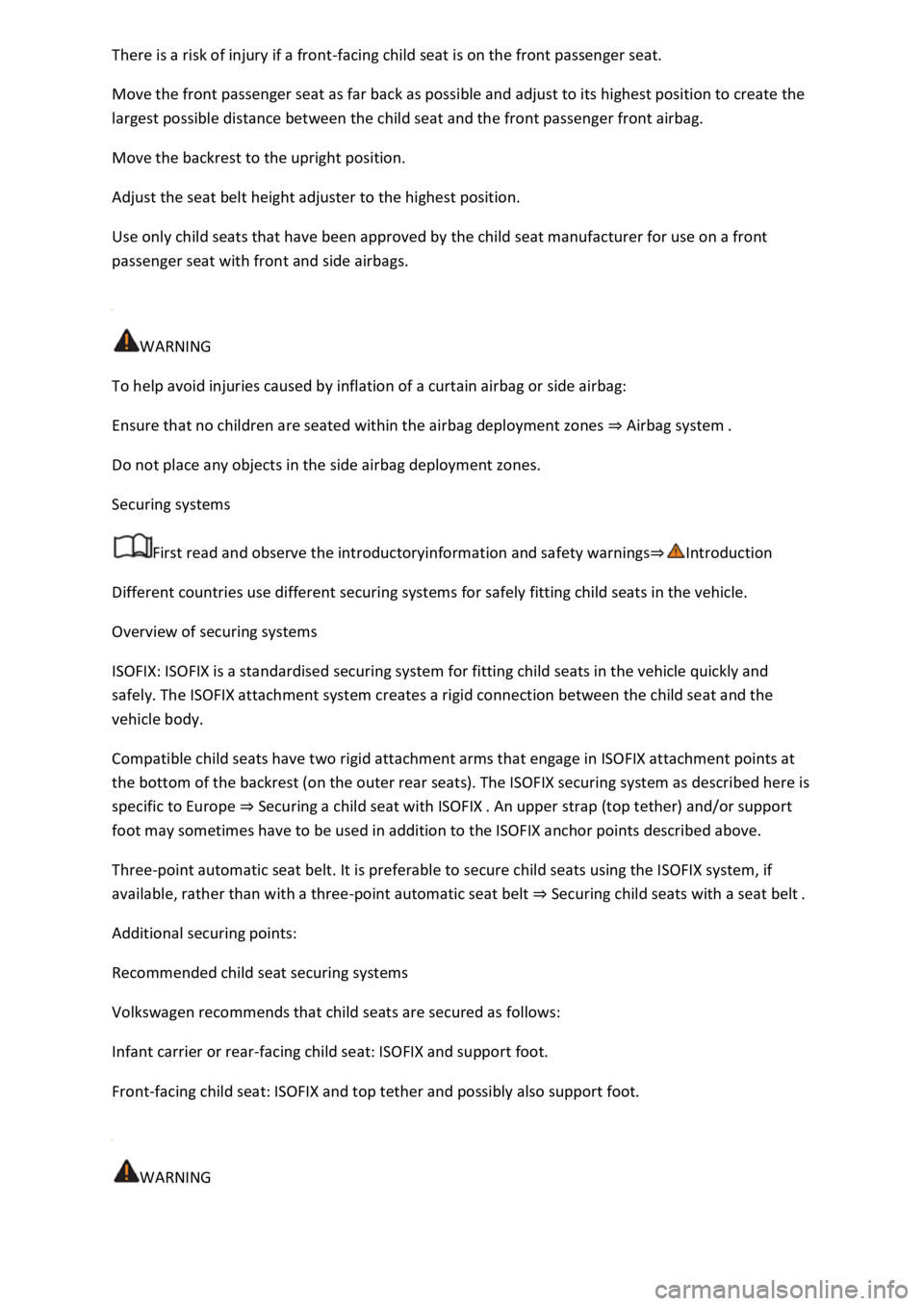
-facing child seat is on the front passenger seat.
Move the front passenger seat as far back as possible and adjust to its highest position to create the
largest possible distance between the child seat and the front passenger front airbag.
Move the backrest to the upright position.
Adjust the seat belt height adjuster to the highest position.
Use only child seats that have been approved by the child seat manufacturer for use on a front
passenger seat with front and side airbags.
WARNING
To help avoid injuries caused by inflation of a curtain airbag or side airbag:
Ensure that no children are seated within the airbag deployment zones Airbag system
Do not place any objects in the side airbag deployment zones.
Securing systems
First read and observe the introductoryinformation and safety warnings
Different countries use different securing systems for safely fitting child seats in the vehicle.
Overview of securing systems
ISOFIX: ISOFIX is a standardised securing system for fitting child seats in the vehicle quickly and
safely. The ISOFIX attachment system creates a rigid connection between the child seat and the
vehicle body.
Compatible child seats have two rigid attachment arms that engage in ISOFIX attachment points at
the bottom of the backrest (on the outer rear seats). The ISOFIX securing system as described here is
specific to Europe Securing a child seat with ISOFIX
foot may sometimes have to be used in addition to the ISOFIX anchor points described above.
Three-point automatic seat belt. It is preferable to secure child seats using the ISOFIX system, if
available, rather than with a three-point automatic seat belt Securing c
Additional securing points:
Recommended child seat securing systems
Volkswagen recommends that child seats are secured as follows:
Infant carrier or rear-facing child seat: ISOFIX and support foot.
Front-facing child seat: ISOFIX and top tether and possibly also support foot.
WARNING